
The Cornell Tech campus on New York City’s Roosevelt Island is an exceptional example of the world’s potential to lower the carbon footprint of real estate. From concept to delivery, sustainability was at the forefront for the entire design and construction team behind the Cornell Tech campus.
Project History
In 2008, to address the significant opportunity for the expansion of the high-tech sector in New York City, Mayor Michael Bloomberg’s office launched a competition to develop an applied sciences campus with a focus on entrepreneurship and innovation, where the winning school would be gifted $100 million of free land for construction. Seven universities submitted formal proposals, and, in December of 2011, the project was awarded to the conjoined bid for Roosevelt Island by Cornell University and the Technion-Israel Institute of Technology. The bid proposed creating 28,000 jobs and $23 billion of economic benefits.
Cornell’s design consisted of two phases, and construction began in 2014 with the demolition of the vacant Coler-Goldwater Specialty Hospital’s South Campus. The full campus plan was designed by Skidmore, Owings & Merrill Architects and Planners and James Corner, Felid Operations Landscape Architects, and the 12-acre project will be fully complete in 2037. Phase I consists of five buildings: the Emma and Georgina Bloomberg Center, The House, the Tata Innovation Center, the Verizon Executive Education Center, and the Graduate Roosevelt Island Hotel, and details about these buildings can be found in the table below. Throughout the entirety of the design and development process, sustainability was paramount. The project team was determined to maximize the sustainable capabilities of this project and minimize the carbon footprint of the campus. While the sustainable features ended up causing roughly $10 million, or an additional 15%, in project overruns, the team did not calculate return on investment metrics, stating “the purpose of these features was our commitment to the planet, not for profit”.
| Building | Construction Period | Size | Architect / Developer | Description and Features |
| Emma and Georgina Bloomberg Center | 2015-2017 |
5-story 160,000 sq.ft |
Morphosis | The home base for students and staff with classrooms and study spaces. LEED Platinum and aspiring Net Zero Energy building. |
| The House | 2015-2017 |
550-bed 26-story 270,000 sq.ft |
Handel Architects
Hudson Companies and the Related Group |
Residential building for students and staff. Passive House and LEED platinum certified building with optimum orientation, super insulation modular facade, and airtightness. |
| Tata Innovation Center | 2015-2017 |
7-story 235,000 sq.ft |
Weiss / Manfredi
Brookfield Properties (Forest City Ratner) |
Home to researchers, start-ups, and academic partnerships, serving as a business incubator for students, staff, and faculty. |
| Verizon Executive Education Center | 2018-2020 | 36,000 sq.ft | Snohetta | An event and conference space. |
| Graduate Roosevelt Island Hotel | 2018-2020 |
224-key 18-story 148,000 sq.ft |
Snohetta / Stonehill Taylor
AJ Capital Partners |
224-key hotel featuring a rooftop lounge, restaurant, and meeting spaces. |
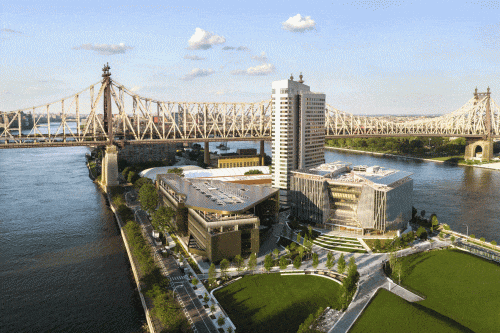

Renewable Energy Journey
In the search for methods to produce renewable energy for the campus, the team explored four energy alternatives: solar power, ground source heat energy, wind power, and hydrodynamic power. The development team conducted several studies over the course of a year to determine which methods would be most efficient, for both energy and cost, based on the natural features of the project site location.
The first method of renewable energy generation explored for the campus was solar energy. Typically, solar energy is difficult to implement in New York City, and specifically in Manhattan, because of the density of high-rise buildings and the shadows they cast. The Cornell Tech campus has the unique advantage of being removed from Manhattan, which means that the team was able to successfully implement photovoltaic canopies on both the Tata and Bloomberg Buildings. These canopies are now the largest solar photovoltaic installation in all of Manhattan. The team prioritized integrating the canopies into the architecture of the building to create a cohesive design.
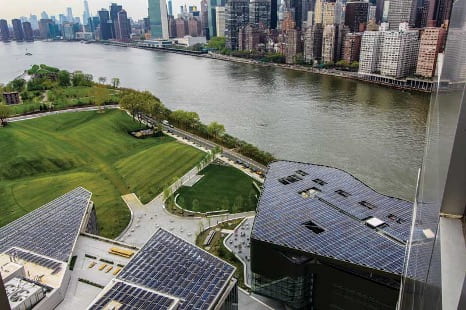

The second method that was implemented into the project design is heat from ground source heat wells. Thanks to these wells, the Bloomberg Center does not burn any fossil fuels. To determine how effective the wells would be for the ultimate project, the team installed a pilot well for a full year to get readings and measurements of production levels. After the year, it was determined that the wells could be implemented successfully, and a closed pure water loop system was created with 80, 6-inch diameter wells installed 400-feet below-grade underneath the campus lawn. The closed-loop system means that it uses the same fresh water throughout the system rather than using the water from the East River; this system was developed as a result of the brackish nature of the river water that would corrode the equipment over time.

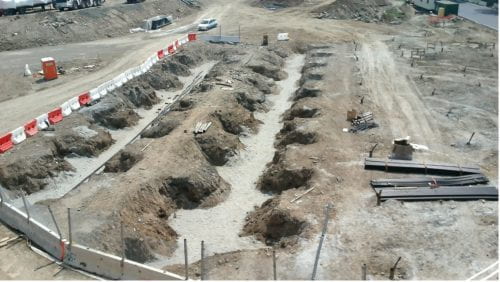
The third method of energy generation investigated was wind power. Before the existing hospital building was demolished, a LIDAR instrument was installed on the roof to detect the wind power for one year. The readings from that year showed that the wind speed was only 8-12 miles per hour on average, which generated insufficient power to earn anything less than a 20-year payback for the instruments. The winds came predominantly from the West, so they were blocked by the skyscrapers in Manhattan. Considering that industrial-grade 2-megawatt wind turbines only have a working life of 20 years, a renewable energy asset that will not earn its payback until the end of its life is an unworthy investment. Plus, the project team was not looking to incorporate a full industrial-grade wind turbine on campus, and so this method of renewable energy generation would have relied on a more compact technology that did not yet exist. Ultimately, it was determined that wind energy was not a strong enough source to pursue this method.
The fourth and final method of renewable energy generation that was investigated was power from hydrodynamic sources. The team placed a prototype water turbine in the East River to conduct readings of how much energy could be collected. Through this innovative process, the team discovered several issues with this method of energy collection. First, there were several regulatory and permitting issues involved with the permanent installation of objects into the East River. Second, the river has a bidirectional current, so the water turbines’ potential would be cut in half. Third, the debris in the river tended to obstruct the turbine blades. As a result of these three issues, this method was not pursued.
In terms of financing both the photovoltaic canopies as well as the geothermal wells, the team initially considered using a power purchase agreement (PPA) for both. A PPA is a contract between two parties where one party provides the facilities to generate renewable energy and another party designs, purchases, and installs the renewable energy equipment. This would have allowed Cornell to forgo initial capital outlays for both these systems and instead pay the external organization, like a utility company, a fixed rate for the electricity and heat these systems produce. Unfortunately, the PPA market in 2014 was not very robust, especially in New York City, and several factors decreased the demand for agreements for this project. For the photovoltaic canopy, the system was integrated into the design of the building; it sits on top of the six-story building, and the time frame for design and construction was very short. The geothermal wells were the largest ground source heating system in an urban setting at the time of development, which made some investors hesitant. Despite putting out a bid for the design, permitting and operations of the renewable energy systems, the bids that Cornell received were priced much too high for the school’s comfort, and so Cornell ended up undertaking the pronouncement of the photovoltaic canopy and the ground source heat themselves.
Additional Sustainable Design Methods
While the focus of this article is discussing the journey to the methods chosen to generate renewable energy on campus, the development team incorporated several other unique features into the campus design that make the overall campus more sustainable. These methods include, but are not limited to, green infrastructure like bioswales, rainwater harvesting tanks, passive house principles, LEED certification, and sustainable demolition practices.
The campus has six bioswales – a greener alternative to storm sewers – that replace the previous method of stormwater management that pushed the rainwater through catch basins, then out to the East River. This new method manages water onsite and only pushes overflow out to the river after it has already been naturally filtered with a thick bed of plantings, rocks, and sand. Another exciting water management feature is the installation of a 40,000-gallon rainwater harvesting tank that collects rainwater from the roof of the Bloomberg Center. The water is then treated with UV and filters; the recycled water is used as gray water in the Bloomberg Center and for lawn irrigation.
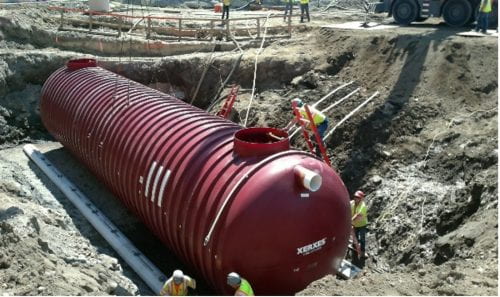
The campus has attained Passive House certification for The House and LEED Silver as the minimum standard for each building on campus, two important measures of building efficiency. The House became the tallest and largest Passive House residential building in the world upon its completion. This designation denotes a rigorous design methodology wherein a building cuts energy use by 60-80% in comparison to code requirements. To obtain this designation, the House has exterior walls with 8-13-inch-thick insulator panels that retain 882 short tons of carbon dioxide annually. LEED Silver designation was a requirement for the campus team; however, the design team went the extra mile by pushing the Bloomberg Center to LEED Platinum and aspires to be one of the largest Net Zero energy buildings in the country.
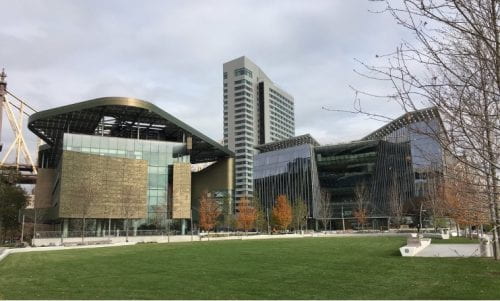
Another conscious decision by the development team was to increase the sustainability of the demolition process to clear the site for the campus. One method that increased the energy efficiency of the demolition process was the use of a debris barge in place of trucks removing debris from the property, saving the equivalent of 5,000 truck trips. There was also a brick and concrete crushing operation for the debris from the demolition of the hospital on the site , and the debris was then used to build up the elevation of the campus.
Takeaways
The Cornell Tech campus shows the innovation that is possible within real estate development. The development team for this project continuously pushed the boundaries of sustainability in real estate by conducting thorough studies prior to construction to determine the best renewable energy sources for the site, pioneering the discussion of a power purchase agreement market at the time of development, and rising above required sustainability standards to achieve astonishing energy savings. With Phase II plans currently under discussion, Cornell students cannot wait to see what the team achieves next.
Information derived from interviews with Cornell Tech’s Director of Construction, Diana Allegretti, and Project Manager, Andrew Fowler
Cornell Tech on path to reach net zero at the Bloomberg Center. Cornell Tech. (2018, November 20). Retrieved June 5, 2022, from https://tech.cornell.edu/news/cornell-tech-on-path-to-reach-net-zero-at-the-bloomberg-center/
LEED rating system. LEED rating system | U.S. Green Building Council. (n.d.). Retrieved June 5, 2022, from https://www.usgbc.org/leed
Richard, M. G. (2020, May 3). The Energy Payback for a 2-megawatt wind turbine that lasts over 20 years is… 5-8 months. Treehugger. Retrieved June 5, 2022, from https://www.treehugger.com/energy-paypack-megawatt-wind-turbine-lasts-over-years-months-4858396
Young, M. (2020, August 20). Exterior work finishes on Verizon Executive Education Center and Graduate Hotel, on Roosevelt Island. New York YIMBY. Retrieved June 5, 2022, from https://newyorkyimby.com/2020/08/exterior-work-finishes-on-verizon-executive-education-center-and-graduate-hotel-on-roosevelt-island.html
YouTube. (2018). Modern Campus Helping to Build the Future of Sustainability | Diana Allegretti | Cornell Tech | Heff. YouTube. Retrieved June 5, 2022, from https://www.youtube.com/watch?v=7Jood7sABlA.
